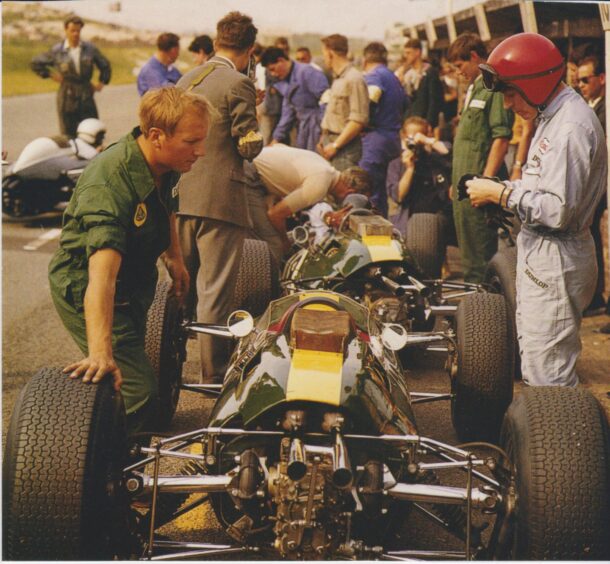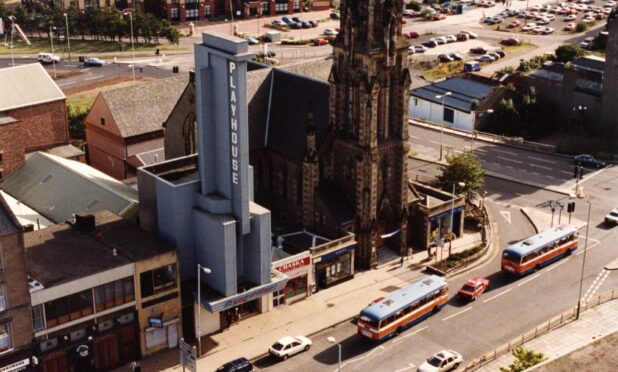When Derek Wild rounded his first corner with Fife racing legend Jim Clark, he thought it would be his last.
“We were at Goodwood Motor Circuit down in West Sussex, and Jimmy was supposed to be testing a space frame chassis car – which he didn’t like anyway,” recalls Derek, one of the six Lotus mechanics who helped Jim drive to F1 World Champion status in 1963.
“There was about an inch of water on the circuit, so we couldn’t test the car,” he continues. “But Jimmy said: ‘C’mon, we’ll have some fun.’
“He had a Lotus Elan, and I sat down next to him in it, and off we went. At the first corner, I thought: ‘This is it, I’m going to die with someone famous!’
“But Jimmy just flicked his wrists and controlled the slides, easy. It was mind-boggling. He was an extremely good, naturally talented driver.
“We were lucky, the other mechanics and I,” Derek adds. “Having people like Jim driving was really quite a thrill for us.”
This is just one of the exciting memories of Jim Clark and his time at Lotus that Derek, now 85, has revisited while writing his newly-released memoir, Wild About Racing.
Comprised of his own stories, as well as many photos he shot behind the scenes of F1, the book has been published by Fife-based motorsport specialist outfit BHP and was launched at the Jim Clark Museum in Duns.
Chief mechanic: ‘Can you start tomorrow?’
Derek became an F1 mechanic unexpectedly. After a five-year apprenticeship straight out of school, he answered an advert from Lotus in his local paper, who were looking for mechanics in north London.
“I thought it was something a bit different,” Derek says cheerfully. “I was about 21, 22. They said: ‘Turn up.’ So I did, and I met the chief mechanic. I gave him all the information he needed and he said: ‘Yep, you’re on. Can you start tomorrow?'”
From there, Derek worked on 2.5l Coventry climax engines “which were in vogue at the time”, before progressing to 1,500CC engines and eventually gearboxes – the speciality which would go on to take him around the world with F1.
Clark ‘smartened up’ but stayed ‘same Jim’
Before long, he met the young Jim Clark, a “lovely, calm” man from Kilmany, who drove down from Scotland in his Porsche to race on weekends, and then drove all the way back up.
“Initially in the ’60s, he was a quiet soul,” recalls Derek. “He just wore his clothes, nothing fancy – just a nice, quiet gentleman.”
As his fame grew, Derek says Jim was forced to change his image somewhat.
“Gradually, as the the year went on, he had to smarten up quite a lot. Because he had to do interviews and open garages, and talk to all sorts of people,” he observes.
However, despite his life changing around him as a result of his success on the circuits, Derek maintains that Clark remained “the same old Jim”.
“Other drivers were there because they’d worked hard and they, in the end, got there,” he explains.
“But someone like Jim or Stirling Moss could go sit on the pit counter, then go out for practice, put in a time, come back and sit on the pit house and wait for someone else to get near the time.
“In the end, they’d just slip back into the car, equal the time and knock off another half second. So he really was talented, amazingly so. It’s difficult to compare modern drivers to ones like Jimmy.”
Detailed car knowledge gave Jim an edge
Part of what made Jim so talented, Derek explains, was his knowledge of the cars he was working with.
“Cars were very delicate in those days, and we had more mechanical problems than they do nowadays,” he says. “Once at Silverstone, Jim kept switching the engine off when he was coming around the corner.
“Apparently the oil pressure had dropped, and it was dropping when he was cornering. So he switched the engine off, wait until the car was straight again, and then switched on again.
“He had a fair bit of knowledge about what he was driving”
This detailed knowledge of the Lotus race cars was helped by Jim’s close relationship with Lotus chief designer and innovative inventor Colin Chapman.
“Jim learned a lot from Colin,” Derek says. “After a testing session or practice session, he’d come in and discuss it with Colin.
“Then Colin would come back with a job list of items to do, which always kept Team Lotus working all-nighters, where many of the other teams all went out at six o’clock!”
Lotus boss Colin Chapman ‘never relaxed’
Indeed, Colin Chapman had a reputation for being a “character”, which Derek laughingly confirms.
“He was a very determined man,” Derek admits. “He virtually never relaxed.
“Even if he was sitting at a meal somewhere, he’d get the survey out and start redesigning a wing or something. He wanted things exactly as he wanted them.
“One time, we got the cars ready to go after a circuit, so we put them up on the ramp, so he could come by and have a quick inspect to see if he was happy.
“He came by and he said the engine mounting hadn’t been painted. He threw a wobbly at me, and then went off upstairs to see the design stuff.
“So I thought, ‘Oh, dear’ and immediately spray painted these brackets.
“When he came down, he shouted: ‘Who the f*** spray painted those brackets?'”
All-nighter in a Dutch hotel kitchen
On another occasion, in 1962, Derek recalls finishing a days-long shift to prepare the revolutionary Lotus 25 monocoque chassis car for Jim to race.
“We worked solidly for a week,” recalls Derek. “I did an all-nighter. And then we finished the car early in the morning, and we pushed it to our fast transporter and I was going home. Then I said cheerio to the two or three mechanics that were going with it, and Colin said: ‘No, you’re going.’
“I’ve got no money, no clothes. I’ve got dirty overalls on, days’ worth of beard. So I said: ‘Well, I’ll just ring home for my passport.’
“No time for that, according to Colin. So when I arrived, of course, the customs dragged me in and gave me a big talking to. And they said if I sent for the passport immediately, they’d let me off.
“So I told Chapman. He said, ‘No, don’t worry about that. We’ve got a race to do.’ He gave me some some money to buy some pyjamas and a toothbrush.
“Then, when we got to the circle in the first practice, we had some gear shift problems. And so it was another all-nighter for me, because I had the gears in the kitchen of the hotel, boiling them to try and clean them, eating strawberries and cream with the hotel chef at 3am.”
Tight-knit team ‘wound up’ the boss
But though they were made to graft, the Lotus mechanic team were as mischievous as they were hardworking. Derek recalls he and the other mechanics winding their boss up by trapping him in a hotel lift in Mexico when he’d left his passport back in the room.
“He was a bit claustrophobic,” chuckles Derek. “He didn’t like tight spaces. And we knew we could stop the lift by putting a bit of paper in it. We could hear banging and swearing, and then we let it down.
“Then he opened the door, and he was all red and flustered. We had a good chuckle at that.”
Mechanics gifted cars after 1963 win
And when Jim Clark went on to win the F1 World Championship in 1963, Derek and his fellow mechanics were handsomely rewarded for their vital contributions.
“In 1962 Chapman said to us: ‘If you win me the World Championship, I’ll buy you all Mini Coopers. Anyway, we didn’t win. But the next year we did, and he kept his word.
“But when he called up Ford Motor Company, they said: ‘Oh no, you can’t give them Minis, we’ll give them Cortina GTs.’ Next thing, he’s asking the six of us which colour we want!”
‘We built cars’ says proud Derek Wild
The golden age of the Lotus team came to a crashing halt in 1968 when Jim Clark tragically died aged 32 in a Formula Two racing accident in Germany.
Shortly afterwards, in 1971, Colin Chapman turned his attention to boat-building company Moonraker Marine.
But Derek and his fellow mechanics stayed in love with race cars, initially breaking away to start their own outfit, Racing Development.
After three years there, Derek went on to work for Modus racing cars, and eventually settle at Van Diemen, where he worked for 35 years until he retired.
“We built cars,” he says with an audible smile. “For some of the top racing drivers ever, we built cars. I’m very pleased to have been a part of that.”
Wild About Racing by Derek Wild, published by BHP Publishing, is available now from the publisher’s website and major retailers. RRP £30.




















Conversation